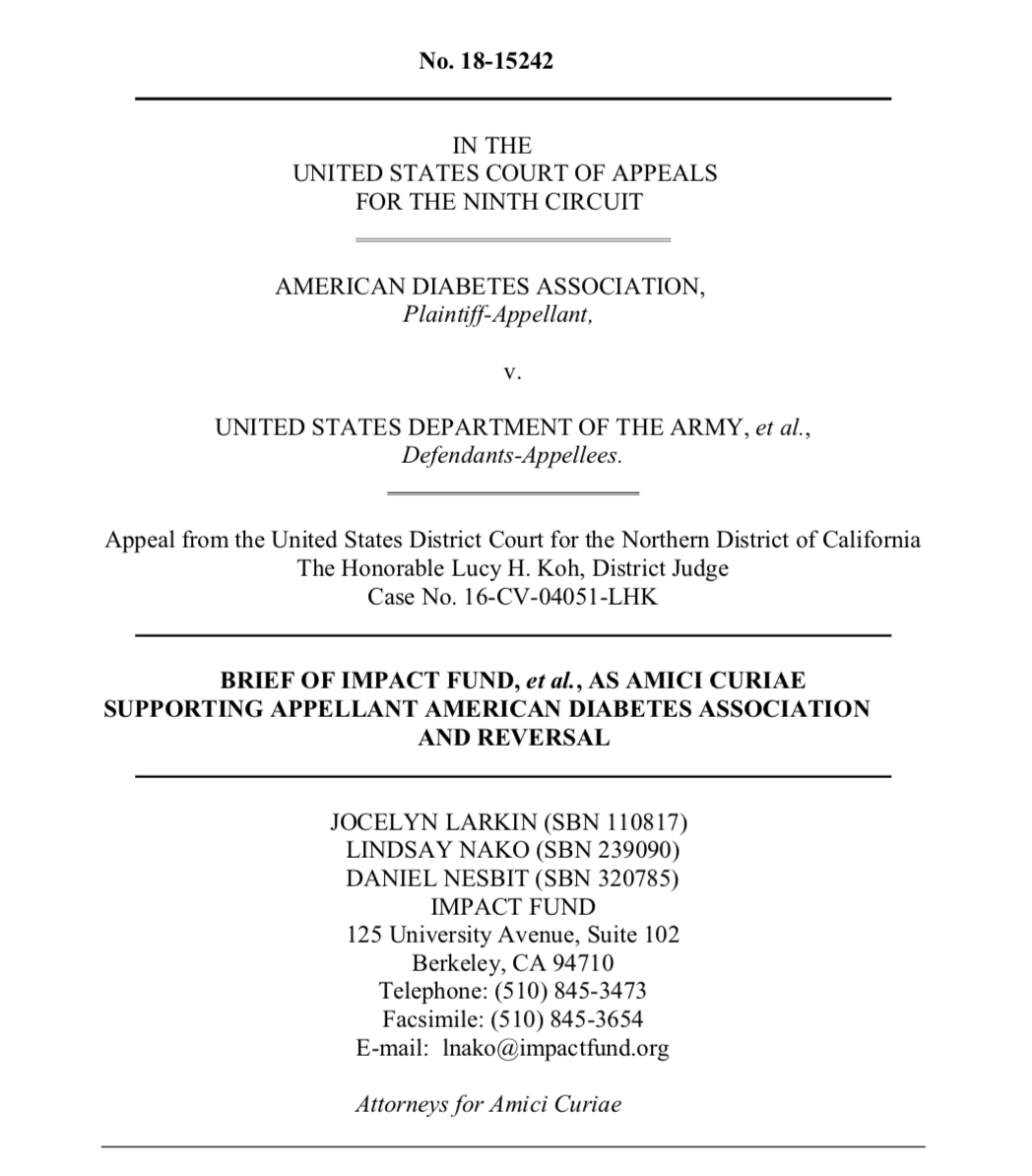Impact Fund Files Amicus On Behalf Of Military's Diabetic Kids
Chanel Cornett, Summer Law Clerk (left) and Daniel Nesbit, Law Fellow
In the United States, 193,000 children under the age of 20 have been diagnosed with diabetes, a disease that requires daily treatment. Many of these children live on military bases where the only reliable and quality childcare for military and civilian families is the Army’s Child, Youth, and School Services (CYSS) facilities. In 2016, the United States Army’s policy was to bar CYSS personnel from providing essential diabetes accommodations, such as counting carbohydrates, administering insulin, and administering glucagon injections. As long as the policy is in place, children with diabetes cannot participate safely in Army CYSS programs and, as such, are excluded from all daycare services, in-home child care services, programs for students and teens, summer camps, and youth sports programs on military bases throughout the country. The American Diabetes Association (ADA), through their counsel, Disability Rights Advocates, brought suit against the Army (M.W. et al v. United States Department of the Army et al) alleging that this policy excludes children with diabetes by violating the Rehabilitation Act of 1973, which prohibits discrimination on the basis of disability in federal government programs.
In the US, 193,000 children have diabetes
During litigation, the Army revised its policy to provide accommodations after a lengthy review process. The ADA filed an amended complaint challenging the new policy.
The district court dismissed the case, holding that the ADA lacked standing to challenge the new policy. The district court’s reasoning in reaching this conclusion is notable for two reasons. First, the district court applied a quantitative standard for what constitutes sufficient injury to establish standing, finding that the ADA had not alleged sufficient harm. Second, it weighed the ADA’s alleged injury relative to its resources. The ADA appealed to the Ninth Circuit, arguing that it properly had standing to challenge the Army’s policy.
We agree. That is why we filed an amicus brief, joined by AARP, AARP Foundation, Animal Legal Defense Fund, Bay Area Legal Aid, Civil Rights Education and Enforcement Center, Law Foundation of Silicon Valley, Legal Aid Association of California, Legal Aid at Work, Legal Aid Foundation of Los Angeles, Legal Services for Prisoners with Children, National Women’s Law Center, Public Interest Law Project, Southern Poverty Law Center, and Worksafe, Inc, that challenges the reasoning of the district court and highlights the importance of organizational standing in civil rights enforcement.
As we explain, standing is like a light switch; a plaintiff has either alleged an identifiable injury or not. The concept of Article III standing is used by the courts to distinguish between a dispute that is properly before the court, rather than an abstract interest intended to be addressed by the legislature. Given this, the Supreme Court and the Ninth Circuit have consistently held that a minimal injury is sufficient to confer standing and have never weighed one’s injury relative to their resources. However, the district court erroneously imposed a quantitative threshold that requires a plaintiff to allege enough injury.We also argue that weighing an organization’s alleged injury relative to its resources is unsupported by precedent and has broad implications beyond just organizational plaintiffs because it would require different showings of harm depending on a plaintiff’s wealth or resources.
Furthermore, a heightened standard threatens the important role of organizations in civil rights enforcement. In the Ninth Circuit, organizational plaintiffs have frequently shined a light on and challenged civil rights violations harming disempowered, marginalized communities including denying access to vote for poor and disabled people (National Council of La Raza v. Cegavske), making it a criminal offense to conceal, harbor, shield, or transport unlawful aliens (Valle del Sol Inc. v. Whiting), and discriminating against black prospective tenants (Fair Hous. of Marin v. Combs). Organizations like the ones in these cases are able to stand in the place of, or alongside, individual plaintiffs to ensure compliance with civil rights laws.
In short, imposing an arbitrary quantitative and comparative standing inquiry effectively erodes the ADA’s, and other organizations’, ability to protect marginalized communities and to ensure that civil rights violations are brought to light.






